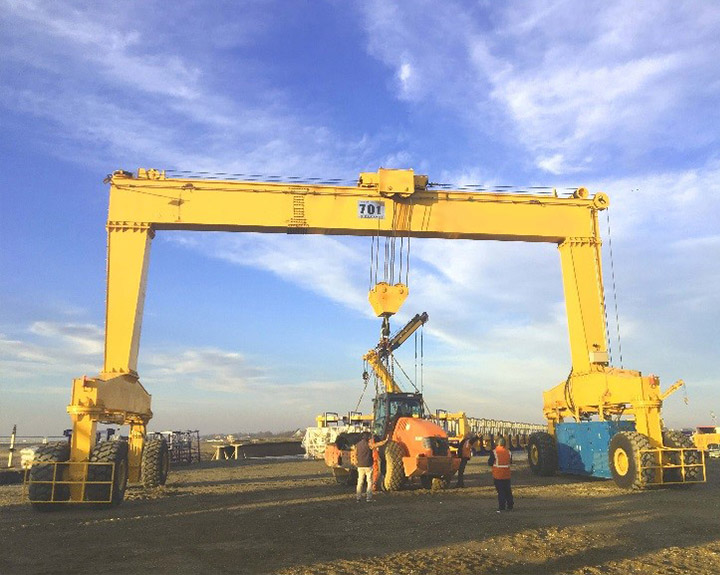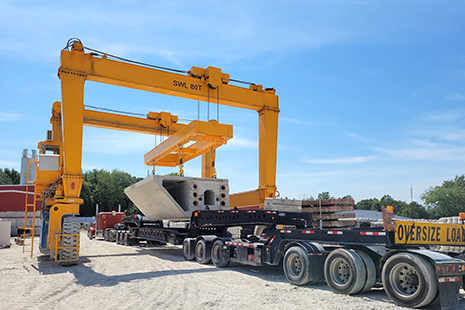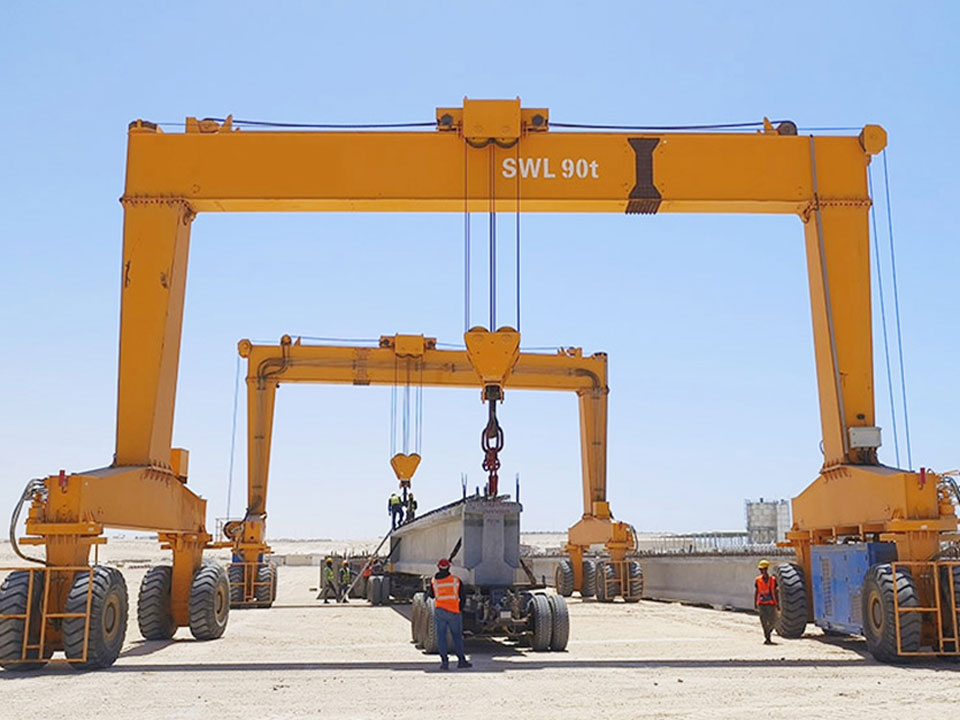Rubber Tired Gantry Cranes (RTGs), as the core equipment of modern logistics and industrial handling, have become the key productivity tools in ports, manufacturing workshops, construction sites and other scenarios, by virtue of their flexible mobility, high efficiency loading capacity, and wide range of environmental adaptability. ports, manufacturing plants, construction sites and other scenarios. These machines are free-moving via rubber tires, without the need for fixed tracks, and can perform heavy-duty handling, precision stacking and cross-region scheduling tasks in complex environments such as container yards, steel warehouses, shipyards and other complex environments. Its core function design is closely centered on improving efficiency, reducing cost and ensuring safety, which is an important cornerstone to promote the efficient operation of the global supply chain.

The main structure of rubber tired gantry crane is welded with high-strength steel, and the main beam and outriggers form a stable gantry structure, which can withstand dynamic loads of tens to hundreds of tons. For example, the main girder is usually designed with a box section, which is internally ribbed to enhance bending resistance and ensure that deformation during lifting is kept to a minimum. The connection between the outriggers and the beams is hinged or bolted, which not only transmits the vertical load, but also adapts to the slight displacement of the tires when walking to improve the overall stability.
In terms of span and height, rubber tired gantry cranes standard models usually have a span of 20-40 meters, with a maximum of 60 meters, which can cover the handling of multiple rows of containers or large industrial components. The lifting height is generally between 15-25 meters, and some specially designed models (such as shipyard-specific rubber tire cranes) can exceed 30 meters, which can meet the requirements of high-level stacking or ship cabin operation.
The design of rubber tires gives the rubber tired gantry excellent terrain adaptability. With solid or pneumatic tires and a ground pressure as low as 0.3-0.5 MPa, the rubber tired gantry is able to drive stably on unhardened gravel roads, muddy fields and even mild slopes without the need to lay tracks. Multi-mode steering system (e.g. 4-wheel steering, crab steering, in-situ rotation) further enhances the flexibility of the machine:
– Crab steering: The machine can be moved sideways, making it easy to adjust its position in confined spaces, e.g. in steel processing plants when handling extra-long steel sections, where the distance between lateral movements can be controlled to within 3 meters;
– Swivel steering: By independently controlling the steering angle of all four wheels, the machine can rotate 360° in place within a 12-meter diameter, adapting to complex scenarios such as the lifting of segments in shipyards.
This flexibility enables the rubber tired gantry to respond quickly to the needs of multi-site scheduling, especially for cross-regional operations between port container yards and rail yards, significantly improving logistics efficiency.
In the field of port and shipping, the core function of rubber tired gantry crane is to realize efficient stacking and transportation of containers. Its lifting mechanism is equipped with double-speed electric hoist or hydraulic drive system, with special container spreader, it can accurately grab 20-foot and 40-foot standard containers, and the single lifting capacity can reach 40-65 tons. Through laser navigation and differential GPS system, the positioning accuracy of the equipment can reach ±10 mm, ensuring the alignment accuracy of containers when stacked in multiple layers in the yard, and improving the utilization of space by up to 30%. For example, in automated terminals, RTGs can work with AGVs (Automated Guided Vehicles) to realize unmanned operation in the whole process of “unloading – transporting – stacking”.
In steel, automobile and other manufacturing scenarios, rubber tired gantry undertakes the task of handling raw materials and finished products. For example, in steel mills, rubber tire crane can grab steel coils weighing up to 50 tons through electromagnetic suction cups or steel coil clamps, and complete the transfer from the hot rolling workshop to the storage area; in automobile assembly workshops, rubber tyred gantry can lift and load large parts such as body frames, and achieve accurate positioning in line with the production line rhythm. Its multi-mode steering ability can flexibly shuttle between machine tools and shelves, avoiding the path limitations of traditional rail cranes.
In the construction industry, rubber tired gantry cranes are mainly used in the lifting of precast concrete components and bridge construction. For example, in assembled buildings, rubber tyred gantry cranes can accurately install prefabricated floor slabs or girders weighing up to 80 tons into a specified position, with millimeter-level positioning accuracy achieved by laser measurement systems. In bridge construction, rubber tire cranes can be moved along temporary paved walkways to lift steel box girders or concrete segments, eliminating the need to rely on fixed rails and dramatically shortening the construction cycle.
Shipyards are one of the most important application scenarios for rubber tired gantry. The equipment can cover the entire shipyard through the large span design, lifting ship segments, main engines and other heavy components. For example, a shipyard uses rubber gantry cranes to move 200 tons of ship power modules, and its rubber tire design can drive stably on the unhardened dock floor, avoiding the damage caused by traditional rail cranes. In addition, some rubber tyred gantry cranes also support amphibious operation, and can directly enter shallow water to assist in launching or disembarking ships.

In order to improve lifting safety and efficiency, modern RTGs are generally equipped with active load control systems. For example, by means of inclination sensors and laser range finders mounted on the spreader, the system monitors the load sway in real time and automatically adjusts the lifting speed and braking parameters to control the cargo sway within ±5 centimeters. This technology is particularly suitable for handling precision machinery or fragile goods, effectively reducing the risk of damage during transportation.
– Remote control: The operator can control the equipment remotely via a wireless remote control or cab console at distances of up to 200 meters or more, avoiding exposure in high-risk environments. Some high-end models also support 5G communication to realize remote real-time monitoring and troubleshooting.
– TOS Integration: rubber tired gantry cranes can be seamlessly integrated with terminal TOS (Terminal Operating System) systems to automatically receive operating instructions and plan the optimal path. For example, Taicang Port has realized autonomous dispatching of rubber gantry crane tasks and guidance of collector trucks through the optimization of the TOS system, with an automation rate of more than 80%.
o RTG: adopts rubber tires, can move freely in multiple scenarios such as ports, yards and factories, and does not need fixed rails.
o RMG (Rail-Mounted Gantry Crane): relies on fixed rails, and its movement range is limited by the track layout. o RMG (Rail-Mounted Gantry Crane): relies on fixed rails and its range of movement is limited by the track layout, suitable for single high-density yard.
o RTG supports multi-modal steering and full terrain adaptation to respond quickly to changes in site layout;
o RMG has higher potential for automation (e.g., with AGVs), but requires additional investment in track infrastructure and is less flexible.
o RTG is suitable for inter-regional handling and temporary yard scenarios;
o RMG is more suitable for large-scale ports or specialized logistics centers with long-term fixed operations.

The main girder is the core load-bearing component of rubber tired gantry, which usually adopts box-type or truss structure, and can withstand bending moments of more than 2,000kN by optimizing stress distribution through finite element analysis. A trolley track is installed underneath to support the transverse movement of the spreader.
The legs and cross beams form the portal frame structure, which adopts box section design and is filled with polyurethane shock absorbing material to reduce driving vibration and improve the anti-roll ability. Tires and steering mechanism are installed at the bottom of the legs to realize the movement and steering of the equipment.
The hoisting mechanism includes electric hoist, hydraulic pump station, wire rope and hook and other components. The wire rope usually adopts 6×37+FC structure, the breaking tension can be more than 540kN, with anti-swing system to ensure the stability of the lifting process.
The control system takes PLC (Programmable Logic Controller) as the core, and integrates functions such as frequency conversion speed control, safety interlock, and condition monitoring. For example, Siemens S7-1500 series PLC supports PROFINET industrial Ethernet, and the response time is less than 10ms, which can realize micro-speed accurate positioning.

Diesel-powered rubber tired gantry is powered by diesel generator sets, which is suitable for remote areas without grid coverage or temporary operation scenarios. Its advantages are strong mobility and long range, but high energy consumption and high emission.
Electric rubber tired gantry cranes are connected to the power grid via cable reels or skid wires to realize zero-emission operation. For example, Fahrer’s ERTG system with lithium-ion battery packs has a range of up to 8 hours and recovers 30% of the kinetic energy into electrical energy when braking.
Hybrid rubber tired gantry cranes combine diesel and electric systems to automatically switch power sources based on load demand. For example, the Kalmar Hybrid rubber tire crane consumes 40% less fuel than conventional models and supports fast charging.
Maintenance of RTGs focuses on inspection of wire rope wear, cleaning of the hydraulic system, and tightening of electrical components. For example, Huadelift provides 4 inspections free of charge in the first year, covering steel structure flaw detection and lubrication point maintenance, and generates maintenance reports in English and Chinese.
o Mechanical Safety: ROPS and impact resistant legs can withstand 1.5 times the rated load;
o Electrical Safety: Emergency stop button, leakage protection system and short circuit response time <0.05 seconds;
o Environmental Adaptation: Hot-dip galvanized anticorrosion coating (with a life expectancy of 20 years) and engine preheating system for extreme environments, such as high salt spray and low temperatures. o Environmental adaptation: hot dip galvanized anti-corrosion coating (20 years life) and engine preheating system, adapt to high salt spray, low temperature and other extreme environments.

Rubber Tired Gantry Cranes have become the core equipment of modern logistics and industrial handling with its excellent mobility, precise lifting ability and intelligent technology. From stacking containers in ports to lifting heavy components in shipyards, the versatility and efficiency of rubber tired gantrys continue to drive productivity gains across industries. In the future, with the further integration of automation technologies (e.g. AI visual recognition, 5G communication) and environmentally friendly power (e.g. all-electric, hydrogen), RTGs will develop in an even smarter and greener direction, providing strong support for the sustainable operation of the global supply chain.
For more technical details about rubber tired gantry crane or customized solutions, please contact Huadelift professional team. We provide one-stop service from equipment selection, installation and commissioning to full life cycle maintenance to help your business run efficiently.